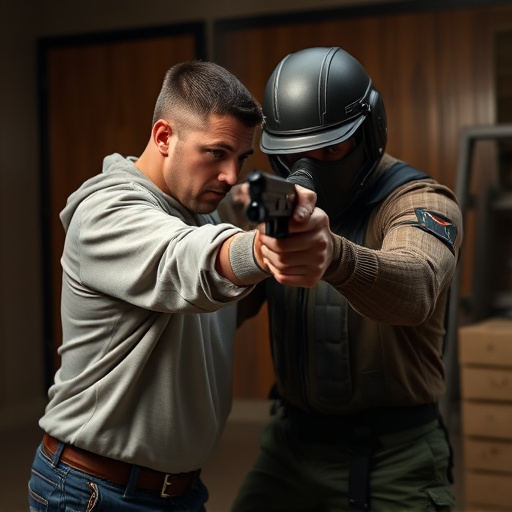Mastering best pepper spray self-defense techniques involves understanding capsaicin, aiming accurately at safe distances, and strategic deployment for temporary incapacitation. Training, proper handling, and regular maintenance ensure effectiveness while minimizing risks. Selecting high-quality products with reliable triggers and one-handed operation enhances safety. Legal compliance is crucial; understand local regulations governing pepper spray use for responsible self-defense.
“Discover the power of riot control pepper spray—a vital tool for personal safety. This comprehensive guide explores best practices, from understanding the chemical’s effects to mastering deployment techniques. Learn how to choose the right pepper spray unit and master training tips for maximum protection.
We’ll navigate legal considerations and regulations, ensuring you’re armed with knowledge on effective self-defense. Uncover expert advice on best pepper spray self-defense techniques to assert your safety in various situations.”
- Understanding Pepper Spray: Its Power and Safety
- Best Practices for Effective Pepper Spray Deployment
- Choosing the Right Pepper Spray Self Defense Unit
- Training and Technique: Maximizing Your Protection
- Legal Considerations: Use and Regulation of Pepper Spray
Understanding Pepper Spray: Its Power and Safety
Pepper spray, a powerful self-defense tool, has become an essential addition to personal safety kits for good reason. Understanding its active ingredient, capsaicin, is key to harnessing its effectiveness. This natural compound, found in chili peppers, causes temporary yet intense irritation when it comes into contact with the eyes and respiratory system. When deployed, pepper spray creates a cloud of tiny particles that can disable an assailant for several minutes, providing users with valuable time to escape potentially dangerous situations.
While pepper spray is an effective deterrent, its power necessitates responsible use and safety precautions. The best pepper spray self-defense techniques emphasize aiming accurately, using the right amount, and understanding the limitations. Proper training ensures individuals can deploy it effectively while minimizing exposure to both themselves and bystanders. With proper knowledge and handling, pepper spray can be a powerful tool for personal protection, allowing users to defend themselves with confidence in various scenarios.
Best Practices for Effective Pepper Spray Deployment
When employing a riot control pepper spray dispenser unit, adhering to best practices ensures its effectiveness in self-defense scenarios. First, always conduct thorough training to familiarize yourself with the device’s mechanics and deployment techniques. Practice target acquisition, ensuring precise aiming for optimal results. Second, maintain proper distance; while pepper spray can be potent, using it too close may result in unnecessary harm or reduced impact.
Additionally, keep the unit readily accessible, allowing for swift deployment during emergencies. Regularly inspect and maintain the device to guarantee its functionality. Remember, the key to successful pepper spray deployment lies in preparation, accurate technique, and a strategic approach tailored to each unique situation, making it an invaluable tool among best pepper spray self-defense techniques.
Choosing the Right Pepper Spray Self Defense Unit
Choosing the right pepper spray self-defense unit is crucial for your safety and peace of mind. When considering the best pepper spray self-defense techniques, factors like power, range, and ease of use play a significant role. Opt for a high-quality product with a strong concentration of capsaicin, the active ingredient responsible for the burning sensation. The range of the spray should be adequate to provide a safe distance from potential threats, typically between 2-4 meters (6-13 feet).
Additionally, look for features like a reliable trigger mechanism and a design that allows for one-handed use. Training in proper deployment techniques is also essential. Regular practice will ensure you can effectively utilize the spray when needed. Remember, the goal of self-defense is to disable an attacker long enough to escape or get help. Choosing the right pepper spray unit and mastering its application are key steps towards enhancing your personal safety.
Training and Technique: Maximizing Your Protection
Training and mastering the best pepper spray self-defense techniques is paramount for anyone looking to enhance their personal safety. It’s more than just carrying a unit; it’s about understanding how to deploy it effectively during a dangerous situation. The key lies in practicing various scenarios, from close-quarters encounters to longer-range interactions. This prepares individuals to react instinctively and accurately when facing an attacker.
Learning the right technique ensures that the spray reaches its target optimally, maximizing its impact while minimizing collateral damage. Training sessions should cover proper grip, aiming, and trigger pull, enabling users to deploy the spray swiftly and precisely. With adequate practice, individuals can transform their pepper spray into a potent self-defense tool, enhancing their ability to deter and escape potential threats, thus promoting personal safety in various environments.
Legal Considerations: Use and Regulation of Pepper Spray
The use of pepper spray as a riot control measure and for self-defense is governed by strict legal frameworks varying across jurisdictions. While it offers a non-lethal way to subdue assailants, its deployment faces stringent regulations to prevent misuse and protect public safety. In many regions, law enforcement agencies are authorized to carry and use pepper spray during high-risk situations or when responding to civil unrest. However, citizens’ rights advocates argue for responsible use, emphasizing the need for proper training and adherence to protocols.
When considering the best pepper spray self-defense techniques, understanding local laws is paramount. Different countries and states have distinct rules regarding who can possess and carry pepper spray, as well as where and how it can be deployed. Knowing these legal boundaries ensures individuals use pepper spray responsibly, avoiding potential legal repercussions while providing a means of protection in emergency situations.
The best pepper spray self-defense techniques rely on understanding its power, proper deployment methods, and legal boundaries. By choosing the right unit, mastering training and technique, and staying informed about regulations, individuals can leverage pepper spray as a valuable tool for personal safety. Incorporating these practices into your defense strategy ensures you’re prepared to face potential threats effectively and responsibly.
